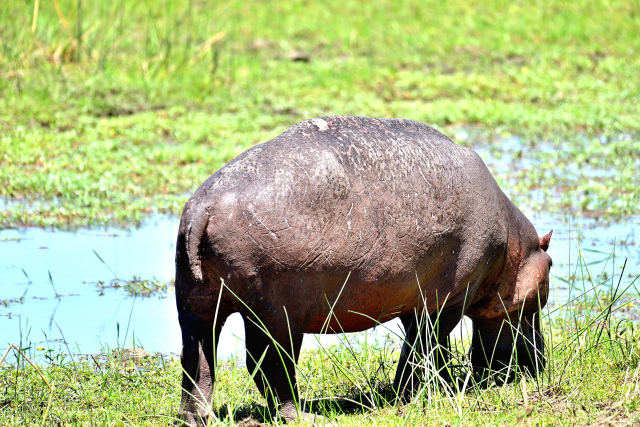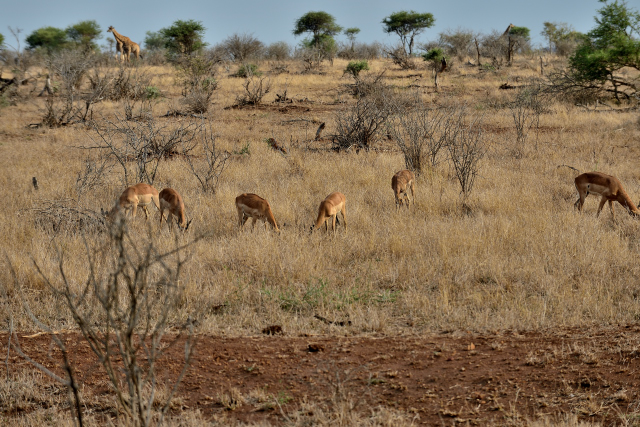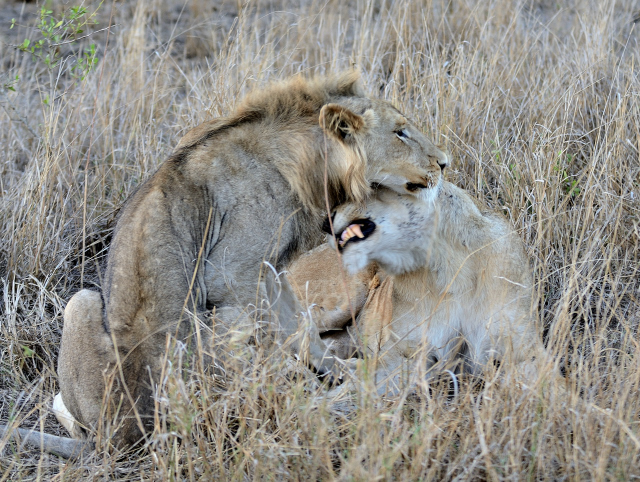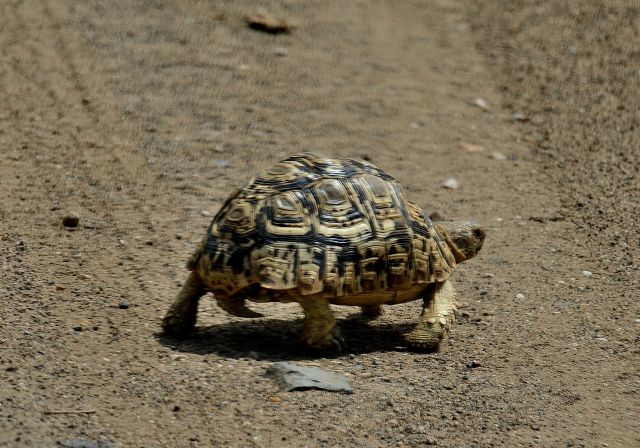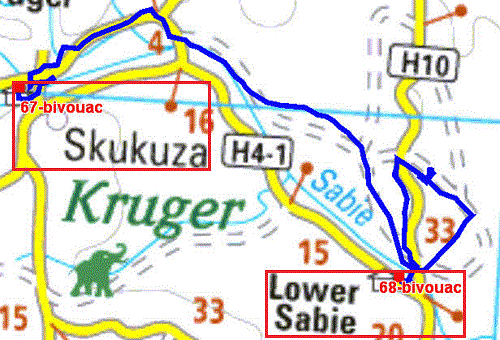
The GPS road tracklog
from Skukuza to Lower Sabie
from 2018/11/26 to 2018/11/26
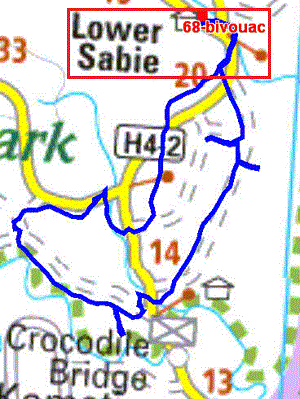
The GPS road tracklog
from Lower Sabie to Lower Sabie
from 2018/11/27 to 2018/11/27
Lower Sabie
According to the procedure established well since my entry in Kruger NP,
I presented myself to the reception of Lower Sabie Camp, then I sought a
site of bivouac which is famous very narrow, it is exact. The buffalo,
very dangerous animal, is very attentive for the car-pooling of the
birds which, on the other hand, remove it from the parasites encrusted
in its skin. The following day I was impressed by the herds of elephants
accompanied by the new-born babies whom the group surrounds to protect
them. On the track it is necessary to remain far because the group can
become aggressive. With my great astonishment the impalas also have
resorts to the car-pooling of the birds while they clean the ears to
them and delouse their back of the parasites. Nature has its ancillary
medical services. The man did not invent anything, the Most High provided
for it! Each species has a very elaborate social life; moreover the
cohabitation of the herbivores as well for the pasture as for water is
done in a good agreement with a precedence according to the mass of the
recipient. Thus to the water supply point when the elephants arrive the
frail impalas give way then return timidly.
click on the pic for opening the gallery
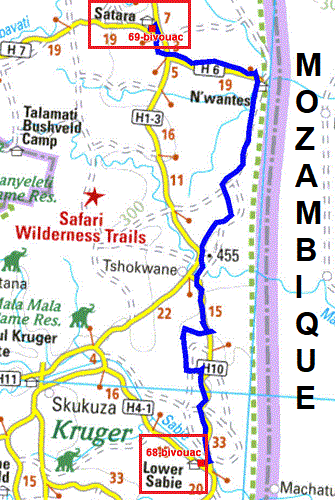
The GPS road tracklog
from Lower Sabie to Satara
from 2018/11/28 to 2018/11/28
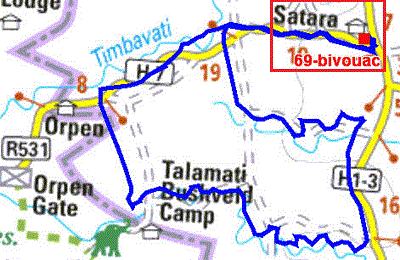
The GPS road tracklog
from Satara to Satara
from 2018/11/29 to 2018/11/29
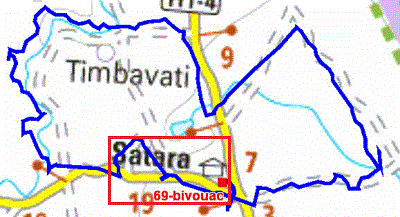
The GPS road tracklog
from Satara to Satara
from 2018/11/30 to 2018/11/30
Satara
Wednesday, November 28 I arrived at Satara Rest Camp for three days.
From Lower Sabie to Satara the harvest of wild animals was thin. Heat
was intense, +38°C in the shade. The animals were hidden, the such
elephants groups under a tree parasol. I stopped at the Orpen dam whose
observatory dominates the very reduced water reserve in this season.
With my binoculars I saw six crocodiles contrary to the saying that
there are not two crocodiles in the same backwater! In fact it is about
a metaphor concerning the human relationship between the members of
gangster groups I remained approximately an
hour in the shade of the observatory to see the technique of surrounding
of two crocodiles, initially of a wader then of a grysbok, but without
success for their meal. Before leaving I have the visit a small animal
that I identified, without certainty, with a mongoose. In end of the
afternoon a violent storm fell down on the bivouac, a true tornado,
resounding bombshells and flashes fulgurating. The temperature in my
vehicle fell abruptly from 42°C to 38°C in less than 20 minutes to
stabilize itself at 26°C one hour later. But the rain was sparse and
lasted little. The night was calm and fresh. The following day I left at
the small-morning with a temperature 19°C which went up to 22°C only
under one overcast sky and windy. The animals were always absent, only
impalas, of course, two or three famished giraffes and some elephants
and their offspring. But at a water supply point, without water, I
discovered a spectacle surprising, some eagles, vultures and a carcass
of animal on the ground; a feast had taken place and, the raptors had
had to finish the remainders besides a jackal ground neighborhood. The
third day I started at a water supply point and with happiness with
water for the animals. I stationed while waiting for the arrival of the
drinkers. In one hour the succession was jackals. Their sealed thirst
they left. Then the hyenas came of number. I left the feeding trough. I
continued my search of wild animals until my return to the bivouac.
click on the pic for opening the gallery
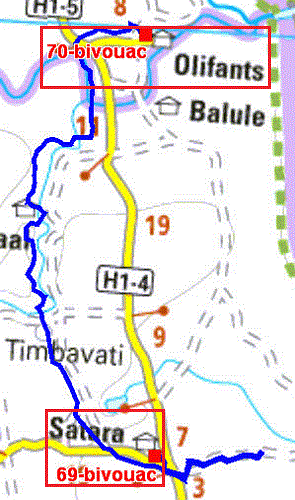
The GPS road tracklog
from Satara to Olifants
from 2018/12/01 to 2018/12/02
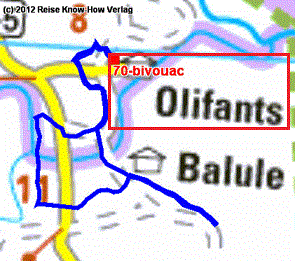
The GPS road tracklog
from Olifants to Olifants
from 2018/12/02 to 2018/12/02
Olifants
Saturday, December 1st I left Satara at the forefront of day. I have the
privilege to discover three lions wallowed in savanna. When they were
branned I saw a lion surrounded by two lionesses. It made large tender
with its partner on right-hand side on the picture then was diverted
towards that one on the left-hand. Disappointed that of right-hand side
had an immense sorrow and pushed a howl, stretched then disappeared in
low-angled light of the rising sun. After this typical scene of the
theater of light comedy of the female eternal, I continued my way by
admiring herbivores having their breakfast by pruning the trees
neighborhood. I arrived at a water supply point whose circumference was
occupied by monkeys baboons. Slowly beautiful impalas went majestically
towards the water supply point to water itself. But they were driven out
by the irascible and dominant monkeys. An impala of high size and gored
lowered its head and charged baboons. The beautiful impalas could drink
to satiety. The power struggles, the territory and the history of the
species belong to the animal kingdom. Let us baboons them, in becoming
homo sapiens sapiens, they would have already assimilated geopolitics?
On the track I met a giraffe accompanied by its offspring walking on the
left side; the British colonizer dictated his law. The giraffe did not
use the metric system. Will it be able to immigrate in the United
Kingdom after Brexit? Finally Southern Ground Hornbill indicated the
track to me to go to Olifants Rest Camp where I had reserved an
air-conditioned country cottage for two days. The following day Sunday
under a hard sun I traversed the tracks neighborhood at the edge of in
low water Olifants River. Few animals were visible. Back to the Camp I
bought a cuddly toy of King Lion, my zodiac sign.
click on the pic for opening the gallery
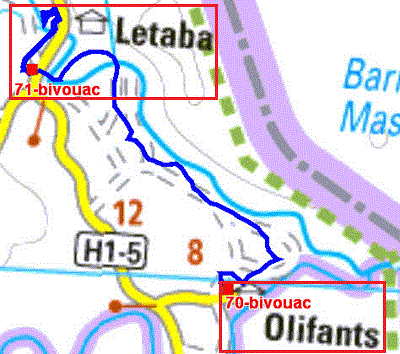
The GPS road tracklog
from Olifants to Letaba
from 2018/12/03 to 2018/12/03
Letaba
Monday, December 3 was my last day in Kruger NP from Olifants to Letaba.
While leaving I noted that it had rained in the night refreshing the
atmosphere. I expected to see many animals, it was not the case. In
Olifant River hippopotamuses branned themselves while disappearing under
water then reappearing and playing together. In an elbow of the track I
was face-to-face with a enormous elephant; it advanced slowly but
unrelentingly. I could not pass it to the risk which it becomes
aggressive; I moved back of 50 meters, it always advanced, I moved back
again and again; approximately 300 meters. Finally it left the track to
go to the shrubs. Then I was the witness of a strange scene. A bird, as
those which are on the back of buffaloes or which clean the ears of the
impalas. But there it is about a giraffe which has an not-identified
object, a branch or a snake! in its right ear. The bird tries a
certainly painful extraction because the giraffe brans itself and
disappears from me field of view. To close this trip in Kruger NP, a
tree with the gigantic trunk, perhaps a baobab tree!
click on the pic for opening the gallery
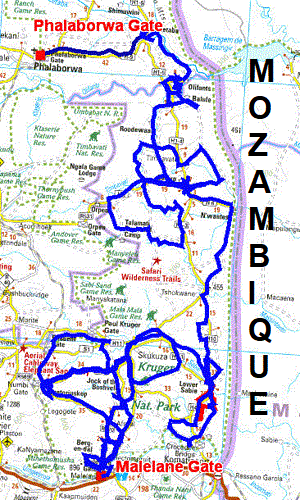
The GPS road tracklog
from Malelane Gate to Phalaborwa Gate
from 2018/11/20 to 2018/12/04
Visit of Kruger National Park
I will not develop the advantages and the disadvantages of Kruger NP. It
is a marvelous park to discover the wild animals. I spent 14 days there
by traversing 1490 km including probably 90% gravel road very often
covered with corrugated at going 5 to 10 km/h with the visual research
of the animals often snuggled in grasses. Kruger NP is 360 km length and
60 km broad. Certain species are plethoric like the impalas, zebras etc.
On the other hand the lions are approximately 1700, the leopards 1000
and the cheetahs only 120. I was lucky!


